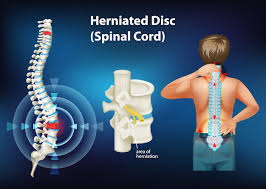

Medically Reviewed by Dr. Chirag Arora
Written by Swasthya Saarthi Editorial Team, last updated on 10 April 2025

A Herniated disc, also known as a slipped or ruptured disc, is a common but often misunderstood condition that can cause significant discomfort and interfere with everyday life. It occurs when one of the rubbery cushions (discs) between the vertebrae in the spine ruptures or slips out of place. Understanding this condition is crucial for managing its symptoms and preventing further complications. In this blog, we'll delve into the causes, symptoms, herniated disc treatment options, and more to help you navigate the complexities of a herniated disc.
A herniated disc is often caused by a combination of factors. The most common cause is aging, as the discs naturally lose water content and elasticity over time, making them more prone to damage. Other factors that contribute to herniation include:

The symptoms of a herniated disc vary depending on the location of the herniation and the severity of the damage. Common symptoms include:
If you're experiencing persistent pain, numbness, or weakness that affects your ability to move or perform daily activities, it's important to seek medical advice. Immediate medical attention is also necessary if you experience:
If you suspect you have a herniated disc, your primary care doctor is a good first point of contact. They can assess your symptoms and recommend the appropriate course of action. Depending on your condition, your doctor may refer you to specialists, including:
If you’re experiencing persistent back pain, numbness, or weakness, consulting a specialist like Dr. Chirag Arora can help you explore effective treatment options.
Exercise can be a key component in managing a herniated disc, helping to alleviate pain, strengthen muscles, and improve flexibility. However, it's crucial to consult with a healthcare provider before beginning any exercise regimen. Some exercises that may help include:
Perform these exercises slowly and gently, avoiding any movements that cause pain.
Herniated disc treatment can range from conservative methods to more invasive interventions. Common treatment options include:
While it may not always be possible to prevent a herniated disc, there are several steps you can take to reduce your risk:

At Swasthya Saarthi, we offer comprehensive care for individuals suffering from herniated discs. Our team of experts includes orthopedic specialists, neurologists, and physical therapists who work together to create personalized herniated disc treatment plans. Whether it's through non-surgical methods like physical therapy, medications, and injections, or through advanced surgical interventions when necessary, we are committed to providing effective and compassionate care to help you manage your condition and regain your quality of life.
A herniated disc can be a painful and disruptive condition, but with proper understanding and treatment, many people can recover and return to normal activities. Early intervention, effective pain management, and the right exercises can help manage symptoms and prevent further damage. If you're struggling with a herniated disc, remember that help is available. Consult with a healthcare provider, explore your treatment options, and take steps to protect your spine and overall health.
A1: In many cases, a herniated disc can heal with conservative treatments like rest, physical therapy, and pain management. However, severe cases may require surgical intervention.
A2: Recovery time varies, but many people experience improvement within a few weeks to a few months with appropriate treatment.
A3: Surgery is typically reserved for severe cases where conservative treatments do not provide relief. Most people can manage the condition with non-surgical options.
A4: Yes, exercise can be beneficial if done correctly. Consult a healthcare provider or physical therapist to ensure you are performing safe and effective exercises.
A5: Avoid heavy lifting, twisting motions, or activities that cause pain. It’s also important to maintain good posture and avoid prolonged sitting.